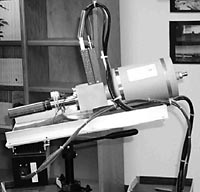Portable mine detector borrows x-ray astronomy methods


A fully portable mine detector that uses x-rays to sense explosives is being tested for demining in Bosnia and Croatia. Unlike other x-ray backscatter systems, the ELF landmine detection system, developed by Henry M. Blair Consulting and System Specialists for ChemTech, doesn't penetrate the ground and image the mines, which requires high powers. Instead, the ELF penetrates slightly below the surface and looks for return fluorescence signals from the effluence given off by explosives. The detector (its name, ELF, stands for "Eliminate Landmines Forever") uses transmitter and receiver optics based on x-ray optics designed for orbiting x-ray observatories. The instrument is still in prototype, but the developers plan to integrate it with a global positioning system (GPS), which will enable the device to provide users with a GPS-referenced map of mine locations.
Around the world, there are more than 100 million antipersonnel mines in the ground, which kill or injure more than 70 people a day-approximately one person every 15 minutes. Moreover, land that is suspected of being mined cannot be used safely until it is cleared of mines. In Croatia, for example, there are a little more than one million mines. "About 12 percent of Croatia can't be used," Blair said. "You have about 10 percent of the population displaced in their own country; they can't go home, go back to their farms, because the area may be mined."
Demining is a slow and dangerous process. The most common form of mine detector is a rod, poked into the ground by hand. Statistically, one deminer dies for every 1000 mines removed. A forward-looking detector with a range of even just a few meters, and which detects and discriminates between mines with different explosives in all kinds of soils and terrain, would save the lives of deminers and significantly increase the speed of determining that an area is clear of mines.
How it worksThe three most common explosives in land mines (TNT, RDX, and PETN) all emit effluence over their entire lifetimes. The effluence rises through the ground (if the mine is buried). The ELF system, which uses lidar techniques, includes a transmitter that emits soft x-rays near .1 nm (see figure). Blair said that unlike ground-penetrating x-ray backscatter systems, the x-ray source does not need to be particularly special, merely portable. The wavelength excites the effluence until it fluoresces. The return signal is concentrated and sensed by a proprietary detector, then processed by the board-level computer using a neural net software that determines which of the explosives produced the gas (each explosive has a distinct signature). Range distance is figured using standard lidar ranging techniques. The system can provide a response to a signal in 300 ms -- effectively real time for this application. The entire system is forward looking and can be carried by a single person, with a second carrying the batteries for the computer and x-ray source.
The ELF is designed to have a range from 1 to 30 m. Blair said, "The head of the demining effort [in Croatia] told me, 'if you can give me two meters, I'll never have another guy die.'" Spatial accuracy is designed to be 12 cm at a range of 30 m. A head-up display will show range and azimuth location. Supplementary GPS-related location data is planned for the beta system.
Alternative methodsDogs have successfully been used for demining. There's some question what the dogs smell, but they are capable of identifying mine locations. The dogs, however, get distracted, bored, and tired, just like people.
The venerable metal detector senses induced current in the casings of a mine. Drawbacks of the system include its inability to detect nonmetallic mines and the common false alarms from any sort of metal.
Other kinds of technologies include infrared heaters and detectors, whcih image mines as hot (or cold) spots that don't belong in a scene. Ground-penetrating radar, mounted on booms or flown over the suspected mine field, show promise. But it doesn't work well on dry soil, produces false positives from rocks and tree roots, and it requires a lot of equipment. X-ray backscatter, nuclear quadrupole resonance, and chemical sniffers all detect the explosives, rather than the casings. These methods are in development as well. For all of the methods, data processing and the signal-to-noise ratios are significant.
Current testingIn December, an early version of the ELF was field tested in Tucson for a team from Mine Action Consultants, which oversees demining projects in Bosnia and in other locations funded by the International Monetary Fund. Four grams of each of three explosives (RDX, PETN, and military TNT) were placed in small cardboard boxes. The three boxes were buried in larger boxes of mineralized soil 20 hours before the first test. A fourth large box of soil was used as the control. The equipment operator did not know which of the large boxes were which. At a distance of 1.5 m, three sets of readings were performed (with the box order changed between readings). After two days, another set of readings were made. The detector correctly identified the contents of the boxes in all 16 readings.
Range testing was scheduled to occur in February in Croatia. Weather permitting, in March, Blair expects the prototype will be tested in the mine fields in that country.
Yvonne Carts-Powell, based in Boston, writes about optoelectronics and the Internet.



